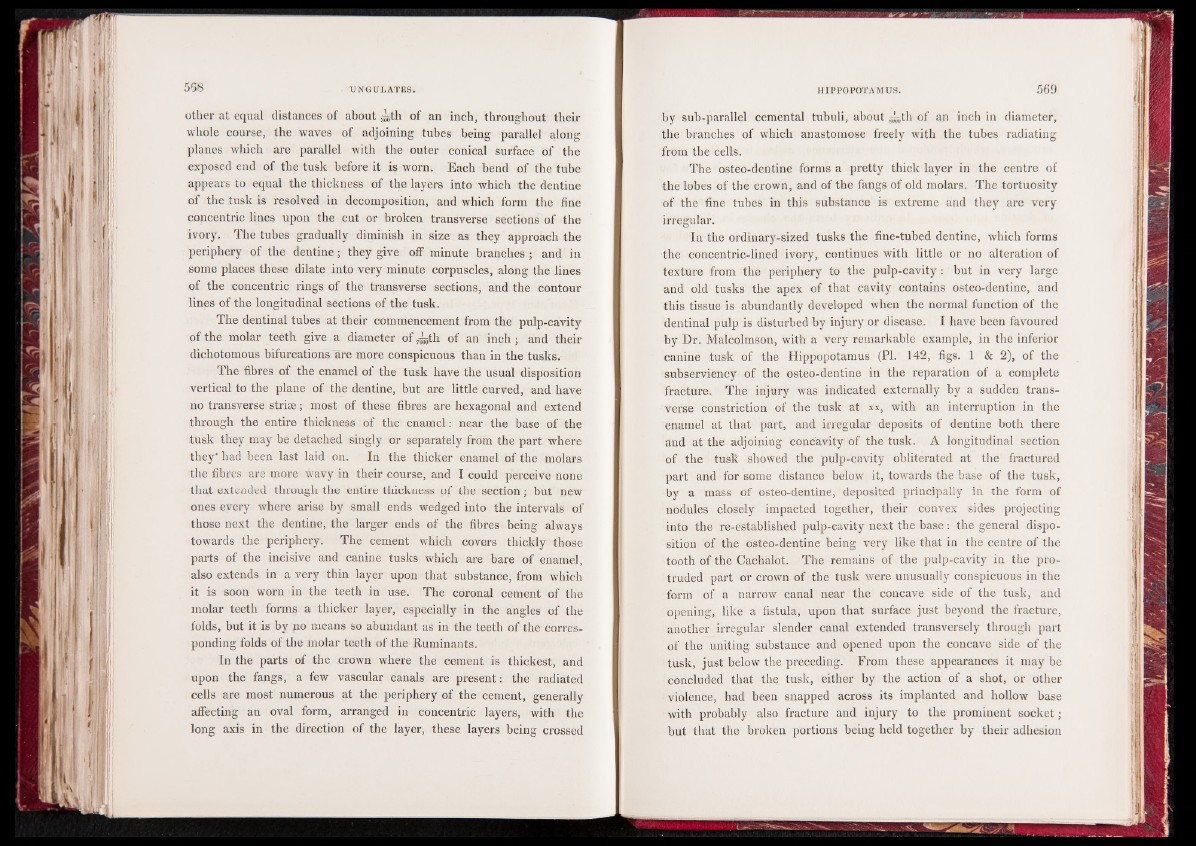
other at equal distances of about ^th of an inch, throughout their
■ whole course, the waves of adjoining tubes being parallel along
planes which are parallel with the outer conical surface of the
exposed end of the tusk before it is worn. Each bend of the tube
appears to equal the thickness of the layers into which the dentine
of the tusk is resolved in decomposition, and which form the fine
concentric lines upon the cut or broken transverse sections of the
ivory. The tubes gradually diminish in size as they approach the
periphery of the dentine| they give off minute branches ; and in
some places these dilate into very minute corpuscles, along the lines
of the concentric rings of the transverse sections, and the contour
lines of the longitudinal sections of the tusk.
The dentinal tubes at their commencement from the pulp-cavity
of the molar teeth give a diameter of ,4th of an inch; and their
dichotomous bifurcations are more conspicuous than in the tusks.
The fibres of the enamel of the tusk have the usual disposition
vertical to the plane of the dentine, but are little curved, and have
no transverse striae; most of these fibres are hexagonal and extend
through the entire thickness of the enamel: near the base of the
tusk they may be detached singly or separately from the part where
they1 had been last laid on. In the thicker enamel of the molars
the fibres are more wavy in their course, and I could perceive none
that extended through the entire thickness of the section; but new
ones every where arise by small ends wedged into the intervals of
those next the dentine, the larger ends of the fibres being always
towards the periphery. The cement which covers thickly those
parts of the incisive and canine tusks which are bare of enamel,
also extends in a very thin layer upon that substance, from which
it is soon worn in the teeth in use. The coronal cement of the
molar teeth forms a thicker layer, especially in the angles of the
folds, but it is by no means so abundant as in the teeth of the corresponding
folds of the molar teeth of the Ruminants.
In the parts of the crown where the cement is thickest, and
upon the fangs, a few vascular canals are present: the radiated
cells are most numerous at the periphery of the cement, generally
affecting an oval form, arranged in concentric layers, with the
long axis in the direction of the layer, these layers being crossed
by sub-parallel cemental tubuli, about gfith of an inch in diameter,
the branches of which anastomose freely with the tubes radiating
from the cells.
The osteo-dentine forms a pretty thick layer in the centre of
the lobes of the crown, and of the fangs of old molars. The tortuosity
of the fine tubes in this substance is extreme and they are very
irregular.
In the ordinary-sized tusks the fine-tubed dentine, which forms
the concentric-lined ivory, continues with little or no alteration of
texture from the periphery to the pulp-cavity : but in very large
and old tusks the apex of that cavity contains osteo-dentine, and
this tissue is abundantly developed when the normal function of the
dentinal pulp is disturbed by injury or disease. I have been favoured
by Dr. Malcolmson, with a very remarkable example, in the inferior
canine tusk of the Hippopotamus (PI. 142, figs. 1 & 2), of the
subserviency of the osteo-dentine in the reparation of a complete
fracture. The injury was indicated externally by a sudden transverse
constriction of the tusk at n , with an interruption in the
enamel at that part, and irregular deposits of dentine both there
and at the adjoining concavity of the tusk. A longitudinal section
of the tusk showed the pulp-cavity obliterated at the fractured
part and for some distance below it, towards the base of the tusk,
by a mass i of osteo-dentine, deposited principally in the form of
nodules closely impacted together, their convex sides projecting
into the re-established pulp-cavity next the base : the general disposition
of the osteo-dentine being very like that in the centre of the
tooth of the Cachalot. The remains of the pulp-cavity in the protruded
part or crown of the tusk were unusually conspicuous in the
form of a narrow canal near the concave side of the tusk, and
opening, like a fistula, upon that surface just beyond the fracture,
another irregular slender canal extended transversely through part
of the uniting substance and opened upon the concave side of the
tusk, just below the preceding. From these appearances it may be
concluded that the tusk, either by the action of a shot, or other
violence, had been snapped across its implanted and hollow base
with probably also fracture and injury to the prominent socket;
but that the broken portions being held together by their adhesion